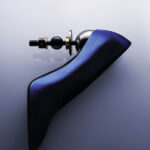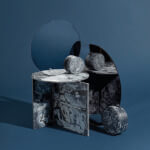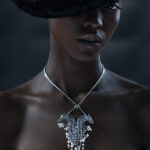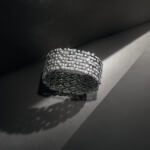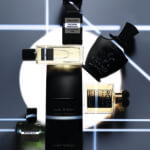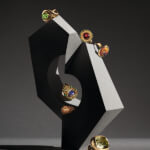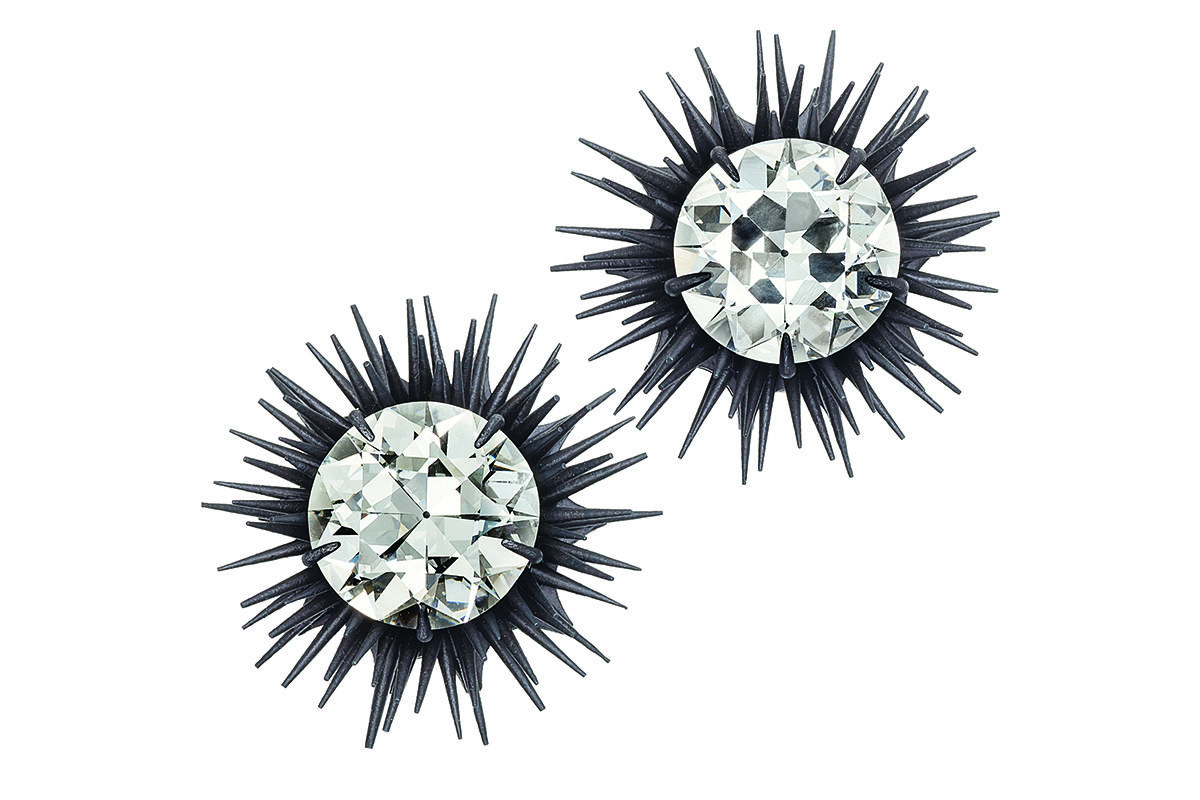
Press
‘Jewellery built bridges between civilizations and formed an integral part of their trade with each other,’ reads the foreword of Coveted: Art and Innovation in High Jewelry by Phaidon. ‘The rich flaunted their jewels as a wearable currency that transcended language, religion, and culture so that a passerby in Egypt, Greece, or Mesopotamia could read another’s status at a glance.’ The book showcases a collection of today’s most exclusive designers including James de Givenchy, Boucheron, Graff, Fabergé, amongst others. We spoke to Melanie Grant, the book’s author, about the evolving relationship that women have with jewellery, some of the standout moments in the book and which first lady she would invite to her fantasy dinner party.
LOVE: What was the first piece of jewellery you were ever given?
Melanie Grant: I remember playing in my grandma’s garden at about six or seven one hot summer in London in the ’80s. She grew marrows and loved roses and I was going through a phase where I hated wearing clothes so I had on willies and pants with all her best jewellery. I think I was ‘helping’ her plant some seeds but really I was just watching her talk to the plants and lovingly tend to her roses. There was a silver marcasite choker I was sporting as a makeshift tiara and she told me to keep it and every time I look at it now, it reminds me of her amid the roses in the sun and all the happiness we shared.
LOVE: The first piece you ever bought?
MG: As a teen I went full Goth and would wonder around Camden market in black leather and chiffon with three or four massive silver crosses swinging at the neck, rings on every finger. I had a thing for skulls, snakes and dragon motifs. Yet the first time I stumbled across the market with its reggae blaring and noodles sizzling, I was transfixed by a simple ring. It was big and silver with an oval shaped amethyst that I felt sung to me as the stone glinted in the light. I think that was the first time I became aware of the power of gemstones and I saved up and bought it.
LOVE: What encouraged you to write Coveted?
MG: It all began in Paris about seven years ago.I was at a CARTIER exhibition to write my first blog and was nervous as hell. I stepped into the quiet darkness of the Grand Palais’ main hall with no idea what to expect and had a spiritual experience, the kind of which I still struggle to understand today. Something happened to me in that auditorium as I took in the sights and smells and breathed in the sheer beauty and glamour of high jewellery fused to history. I left knowing I had to find a way to be closer to it. To write about and understand its significance and to share that with others.
As I wrote more about it I realised there was a hierarchy in the arts that was alluded to be rarely discussed openly that put fine art (sculpture, paintings, photography) at the top and decorative art (jewellery, pottery, furniture) much lower down. I wanted to know why. Was it because the fine arts were considered more intellectually rigorous? Did the functionality of decorative arts make them less important? What I felt in Paris moved me and I became obsessed with the question ‘can jewellery be art?’ not craft but art. And here I am.
LOVE: High jewellery and art are closely linked? Where does the line blur? Does it?
MG: I think jewellery is art at a certain level. Get past tinny trinkets from the high street, the glassy playfulness of costume jewellery as good as that can be and the sometimes shallow seduction of fine jewellery with it’s twinkly diamonds and conservative design and you get to high jewellery.
This is one off, museum quality body sculpture that can take a decade to create and it possesses an unquantifiable force just like any other art form, compelling collectors to sometimes pay millions for it. High jewellery stands apart but it needs to be given more respect and it’s meaning explained for us to understand its importance. Daniel Brush, an artist based in New York for example, produces art in a variety of mediums and jewellery just happens to be one alongside sculpture and painting. It is simply another expression of his creative truth.
LOVE: How do you think women’s relationship with jewellery has changed over the years?
MG: In my book I talk about Elizabeth I because she used jewellery to assert her dominance by creating a presence so astounding, so magnificent with pearls threaded into her hair and gemstones sown into her clothes that her detractors were in awe.Female power has changed a lot since then and as women went into the work force in greater numbers after WWII and began making their own money, they starting buying jewellery to demonstrate their individual taste and economic power.
By the ’80s women began to climb the greasy pole in terms of a career on Wall Street and in the city but I think they were fearful of showing too much femininity so jewellery was kept to a minimum as a string of pearls or pair of small diamond studs. Now I see CEOs in great ropes of beads, Presidents and Prime Ministers with huge brooches and entrepreneurs with knuckle-duster rings.This tells me that our journey with jewellery is evolving alongside female power in society.
LOVE: The industry is mainly dominated with male designers, why do you think that is and is it changing?
MG: I think that is changing as women gain more confidence and try new things. The vast cost of materials (think big diamonds, gold, platinum and hiring workers to make the finished pieces) stop a lot of women in their tracks at the high end but some are challenging the idea of what jewellery can be. Evelyn Markasky uses copper, concrete, melted down credit cards and even a rice noodle in her work from California. Others like Claire Choisne, the Creative Director at Boucheron in Paris has used aerogel in her latest high jewellery collection, a substance NASA has used to capture stardust.
These women represent a new generation of innovation, which for me says, if you can’t get into the club start your own. Nadia Morgenthaler, a Swiss based jeweller worked for many years behind the scenes running a workshop before she took the plunge with her eponymous collections.Understanding the industry from a technical standpoint and also from the inside will definitely help dismantle any remaining resistance.
LOVE: Talk us through some of the stand out pieces in the book?
MG: This emerald and bronze ring by German and Egyptian family jewellers Hemmerle was being made when I visited their workshop last year in Munich to interview them for the book. Individual stones were being set underneath a large emerald and as you can see the affect resembles a green looking glass. This is typical of their Bauhaus, minimalist style, which combines German constraint with the heat of African colour. They are one of the best jewellers in the world right now (p.21)
The feathers bracelet by H Stern, a Brazilian design house is a piece of engineering with literally thousands of tiny metal feathers connected by links all chiming as they move together. Indian culture places great value on the sound that jewellery makes as a woman enters the room, almost as a method of seduction and I like that idea.This bracelet actually pays homage to the Native American tradition of weaving feathers into clothes to show great reverence to the spirit world, which is also a beautiful notion (p.181)
As I said earlier, I’ve always had a thing for snake jewellery and if I were to time travel back in time I’d go back to Ancient Egypt where snakes were rife. This ring is wonderful and by Wendy Yue who hails from Hong Kong however and it’s that mix of white agate, diamonds and opals that give texture and life to her bejewelled serpents. Yue is self-taught which seems impossible looking at this design and for her snakes took on a new significance when a client bought an entire collection of them when she needed it most. (p.146)
LOVE: What surprised you most making this book?
MG: How long it took. I took a three-month sabbatical from work and it took me three years in the end! Also how much support I’ve had because I’m saying some quite contentious things about the power dynamics in art, jewellery and society. I grew up in a council house in North London as a woman of colour so I’m about as far away from this rarefied world as it’s possible to get and yet I was genuinely welcomed. I think my difference has enabled me to see things from a unique perspective and that has been a definite advantage when questioning the status quo.
LOVE: Who was the most prolific jewellery designer of all time?
MG: Prolific is hard to quantify because each era has it’s own heroes but I’d say Suzanne Belperron for me changed design. She came from nothing, born in 1900 in Eastern France and she created poetry. Deliciously curvaceous hammered gold rings, big sensuous rock crystal brooches peppered with moonstones and just agonisingly simple yet strong lines at a time when women were barely allowed to work. She was a disrupter and modernism personified. If I had a fantasy dinner party I’d have Michelle Obama on one side and Belperron on the other.
Image: Diamonds (5.47 and 5.02ct) in blackened iron and white gold, Private collection. Picture credit: Courtesy Hemmerle (page 21)
Original article: www.thelovemagazine.co.uk/article/author-melanie-grant-on-her-new-book-coveted-art-and-innovation-in-high-jewelry-by-phaidon
Written by Harriet Verney, The Editor on 6th October 2020.

